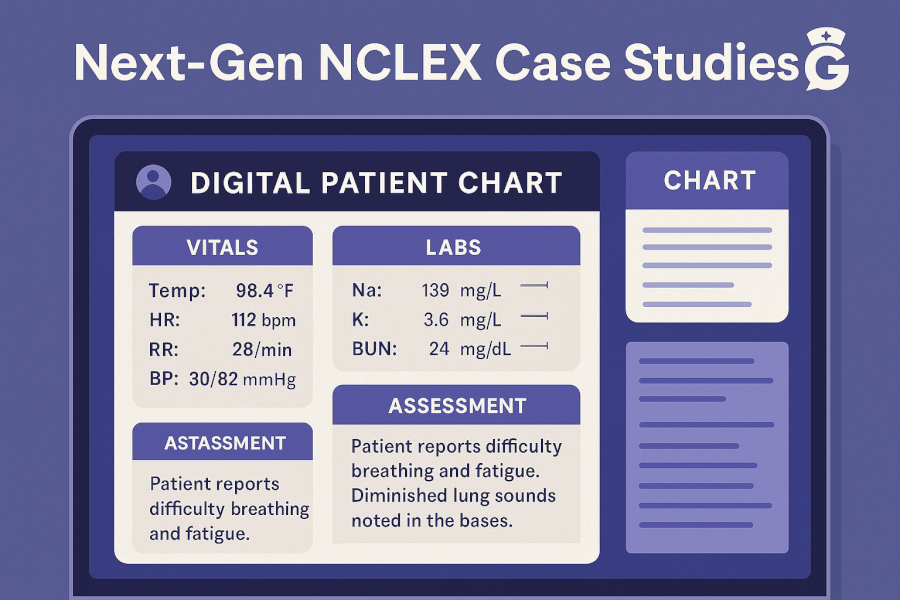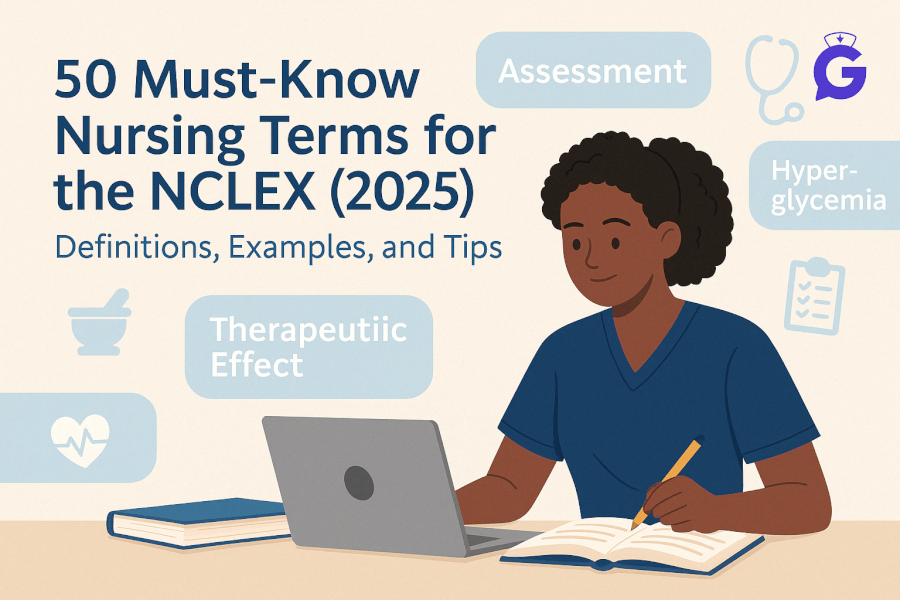Next Gen NCLEX Case Studies: 25+ Practice Questions with Answers
The Next Gen NCLEX (NGN) has redefined nursing prep for 2025, emphasizing clinical judgment, unfolding case studies, and real-world decision-making. Memorizing facts won’t cut it anymore—you need to think like a nurse. That’s why we’ve packed this Next Gen NCLEX prep guide with 10 case study practice scenarios and over 25 exam-style questions, complete with rationales and powered by GoodNurse—the only AI built for nursing students.
Table of Contents
- What Are Next Gen NCLEX Case Studies?
- Case Study #1: Respiratory Distress
- Case Study #2: Chest Pain
- Case Study #3: Pediatric Dehydration
- Case Study #4: Confusion in Elderly
- Case Study #5: Diabetic Ketoacidosis (DKA)
- Case Study #6: Postpartum Hemorrhage
- Case Study #7: COPD Exacerbation
- Case Study #8: Acute Stroke
- Case Study #9: Sepsis in Elderly
- Case Study #10: Pediatric Asthma
- How to Master NGN Case Studies
- Final Thoughts
What Are Next Gen NCLEX Case Studies?
Next Gen NCLEX case studies are 6-question clinical scenarios that assess real-world nursing decisions using formats like:
- Multiple Choice
- Matrix/Grid
- Select All That Apply (SATA)
- Drop-down
- Drag-and-Drop
- Highlight Text
They test six core clinical judgment skills: Recognize Cues, Analyze Cues, Prioritize Hypotheses, Generate Solutions, Take Action, Evaluate Outcomes.
Practice consistently to build this muscle—GoodNurse simulates NGN case studies to help you prepare smarter.
Case Study #1: Respiratory Distress
Patient: 64-year-old male, POD1 after abdominal surgery.
S/S: SOB, RR 28, SpO2 89%, BP 128/76, alert and oriented.
Q1: What is the priority intervention?
- a) Call rapid response
- b) Apply oxygen ✅
- c) Elevate HOB
- d) Administer PRN pain med
Rationale: Oxygen is the first-line treatment for hypoxia.
Q2: What’s the likely cause?
- a) Pneumothorax
- b) Atelectasis ✅
- c) Myocardial infarction
- d) Hypoglycemia
Rationale: Post-op patients commonly develop atelectasis due to shallow breathing.
Case Study #2: Chest Pain
Patient: 58-year-old female in ED.
S/S: Chest pain radiating to jaw, nausea, diaphoresis. BP 140/90.
Q1: What orders should be prioritized?
- a) Administer Tylenol
- b) Perform 12-lead ECG ✅
- c) Draw blood cultures
- d) Administer antibiotics
Rationale: ECG is necessary to rule out STEMI.
Q2: What findings are most concerning?
- a) Mild nausea
- b) Diaphoresis
- c) Chest pain with radiation ✅
- d) Mild anxiety
Rationale: Radiation to the jaw or arm + diaphoresis signals possible MI.
Case Study #3: Pediatric Dehydration
Patient: 3-year-old with diarrhea and vomiting.
Labs: BUN 30, Na+ 150, HR 140.
Q1: What lab is most concerning?
- a) Potassium 4.2
- b) Sodium 150 ✅
- c) BUN 18
- d) Glucose 95
Rationale: Sodium above 145 indicates hypernatremia and severe fluid loss.
Case Study #4: Confusion in Elderly
Patient: 84-year-old with history of UTI. Suddenly confused and agitated.
Q1: Likely diagnosis?
- a) Dementia
- b) Delirium ✅
- c) CVA
- d) Normal aging
Rationale: Sudden onset suggests delirium—often UTI-related in elderly.
Case Study #5: Diabetic Ketoacidosis (DKA)
Patient: 17-year-old Type 1 diabetic.
S/S: Fruity breath, confusion, Kussmaul respirations.
Q1: First priority?
- a) Give insulin
- b) Start IV fluids ✅
- c) Check reflexes
- d) Obtain consent for imaging
Rationale: Fluid replacement comes before insulin in DKA.
Case Study #6: Postpartum Hemorrhage
Patient: 28-year-old postpartum, saturated pad in 10 minutes.
Q1: Next best action?
- a) Reassess in 15 min
- b) Massage fundus ✅
- c) Administer Pitocin
- d) Call NICU
Rationale: Fundal massage addresses uterine atony—the most common cause.
Case Study #7: COPD Exacerbation
Patient: 71-year-old with history of COPD. O2 sat 88%, wheezing, fatigue.
Q1: What med should be administered first?
- a) Albuterol nebulizer ✅
- b) Long-acting beta agonist
- c) Lasix
- d) Morphine
Rationale: Albuterol relieves bronchospasm quickly.
Case Study #8: Acute Stroke
Patient: 69-year-old, slurred speech, facial droop, confusion.
Q1: What is priority?
- a) Administer aspirin
- b) Perform stroke scale ✅
- c) Reassure the family
- d) Check glucose
Rationale: NIHSS scoring is necessary to determine severity.
Case Study #9: Sepsis in Elderly
Patient: 82-year-old with confusion, tachycardia, temp 102°F.
Q1: Best initial nursing action?
- a) Reorient
- b) Administer fluids ✅
- c) Start antibiotics
- d) Call code
Rationale: Fluid resuscitation is priority in early sepsis protocol.
Case Study #10: Pediatric Asthma
Patient: 8-year-old with wheezing, coughing, and accessory muscle use.
Q1: Priority medication?
- a) Fluticasone
- b) Albuterol ✅
- c) Prednisone
- d) Montelukast
Rationale: Short-acting bronchodilator opens airways fast in acute attacks.
How to Master NGN Case Studies
- ✅ Use AI-based simulation tools like GoodNurse to practice daily.
- ✅ Focus on rationales to build decision-making logic.
- ✅ Practice all formats: matrix, SATA, drag-and-drop, etc.
- ✅ Start with 1 case/day and scale up to build endurance.
Final Thoughts
The Next Gen NCLEX is all about real-life thinking—not memorization. These 25+ case-based questions will help you develop clinical judgment, fast. Combine this with GoodNurse's AI-powered support to get NCLEX-ready the modern way.
Try GoodNurse for Free — Thousands of nursing students trust it to simulate NGN-style questions, build flashcards, and track weak areas instantly.
Meta Description
25+ Next Gen NCLEX case study questions with answers for 2025. Practice clinical judgment using real nursing scenarios. Pass with GoodNurse AI.






